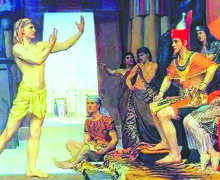
La Virgen María y la Diosa ISIS
The Virgin Mary and the Goddess ISIS
Cabe aclarar que el presente análisis es únicamente histórico y no representa ni juzga creencias religiosas, solo se detiene en la comparativa entre la diosa egipcia Isis y la Virgen María, ya que ambas figuras comparten similitudes notables, aunque pertenecen a tradiciones culturales y religiosas completamente diferentes.
La Diosa Isis comenzó a ser venerada hace 4.700 años, para ser exactos, en el año 2686 a.C, cuando resucita a su esposo Osiris para engendrar a su heredero Horus.
Osiris, Isis y Horus fueron las deidades egipcias más adoradas, ya que los Faraones eran la manifestación de Horus en la tierra, por lo cual Isis era su madre celestial y Osiris ayudaba y protegía a los muertos para entrar en la otra vida, donde los esperaba el Dios RA, el creador del Universo.
Por esa razón era muy importante la trinidad formada por Osiris dios de los muertos, Isis diosa de la vida y Horus, su hijo, dios de la tierra.
Griegos y Romanos
Entre los años 323 al 30 a.C. Egipto fue colonizado por los griegos, de esta forma, los dioses egipcios se fusionaron con los griegos ampliando sus características, por ejemplo, la Diosa Isis se transformó en la protectora del matrimonio y la familia.
Cuando los romanos conquistan Egipto y Grecia los dioses son asimilados por los romanos como propios, hasta que el Emperador Constantino, (272-337) se convierte al Cristianismo en el año 312, que es cuando emite el edicto de Milán, que declaró al cristianismo como principal religión en el Imperio Romano, convocando el Primer Concilio de Nicea en el año 325, que produjo la declaración de fe cristiana conocida como la Credo de Nicea, que confirma por mayoría de votos la Divinidad de Jesucristo, ya que hasta ese momento Jesús era considerado un profeta no divino por parte de los cristianos Arrianos.
Esta asimilación de dioses transforma a la sagrada familia de Osiris, Isis y Horus en José, María y Jesús, aunque los Gnósticos del siglo IV y los Cataros del siglo XII, continuaron venerando a ISIS como diosa madre.
Parecidas pero diferentes
Tanto Isis como la Virgen María son conocidas por su papel como madres y protectoras, siendo Isis, en la mitología egipcia, la madre de Horus, el dios de la tierra y la guerra y, en la tradición cristiana, la Virgen María es la madre de Jesús, el Hijo de Dios, ambas figuras simbolizan la maternidad y la protección materna hacia sus hijos y el resto de la humanidad. Por esta razón, la Diosa egipcia Isis y la Virgen María son consideradas símbolos de la feminidad en sus respectivas culturas, representando la compasión, el amor maternal y la ternura en medio de los desafíos y tribulaciones.
Isis es considerada la Diosa con poderes mágicos en la religión del antiguo Egipto, atribuyéndole la capacidad de resucitar a su esposo Osiris y jugar un papel crucial en su mito de la resurrección, en contraste, la Virgen María es una figura humana, venerada por ser la madre de Jesús, el Hijo de Dios en la teología cristiana. Esta diferencia en la naturaleza divina es fundamental en la comprensión de estas figuras.
La Virgen María es objeto de una devoción masiva en la Iglesia Católica y en otras ramas del cristianismo, a la que le rinden homenaje como protectora, por otro lado, el culto a Isis en el antiguo Egipto fue prominente en su época, pero no se mantiene en la misma medida en la actualidad, ya que es principalmente de interés histórico y arqueológico.
No hay duda de que ambas tuvieron influencia en la historia, el arte, la música y la cultura de su tiempo, siendo fuente de inspiración para innumerables artistas de su época.
It is worth clarifying that this analysis is solely historical and does not represent or judge religious beliefs, it only stops at the comparison between the Egyptian goddess Isis and the Virgin Mary, since both figures share notable similarities, although they belong to completely different cultural and religious traditions. .
The Goddess Isis began to be worshiped 4,700 years ago, to be exact, in the year 2686 BC, when she resurrected her husband Osiris to father her heir Horus.
Osiris, Isis and Horus were the most worshiped Egyptian deities, since the Pharaohs were the manifestation of Horus on earth, for which Isis was their heavenly mother and Osiris helped and protected the dead to enter the afterlife, where the God RA, the creator of the Universe, was waiting.
For this reason, the trinity formed by Osiris, god of the dead, Isis, goddess of life, and Horus, his son, god of the earth, was very important.
Greeks and Romans
Between the years 323 to 30 BC. Egypt was colonized by the Greeks, in this way, the Egyptian gods merged with the Greeks, expanding their characteristics, for example, the Goddess Isis became the protector of marriage and family.
When the Romans conquer Egypt and Greece, the gods are assimilated by the Romans as their own, until the Emperor Constantine (272-337) converts to Christianity in the year 312, which is when he issues the Edict of Milan, which declared Christianity as the main religion in the Roman Empire, calling the First Council of Nicea in the year 325, which produced the declaration of Christian faith known as the Nicene Creed, which confirms by majority vote the Divinity of Jesus Christ, since until that time Jesus He was considered a non-divine prophet by the Arian Christians.
This assimilation of gods transforms the sacred family of Osiris, Isis and Horus into Joseph, Mary and Jesus, although the Gnostics of the 4th century and the Cathars of the 12th century continued to venerate ISIS as a mother goddess.
Similar but different
Both Isis and the Virgin Mary are known for their role as mothers and protectors, with Isis, in Egyptian mythology, being the mother of Horus, the god of earth and war, and, in Christian tradition, the Virgin Mary being the mother of Jesus, the Son of God, both figures symbolize motherhood and maternal protection towards her children and the rest of humanity. For this reason, the Egyptian Goddess Isis and the Virgin Mary are considered symbols of femininity in their respective cultures, representing compassion, maternal love and tenderness in the midst of challenges and tribulations.
Isis is considered the Goddess with magical powers in the religion of ancient Egypt, attributing her the ability to resurrect her husband Osiris and playing a crucial role in his resurrection myth, in contrast, the Virgin Mary is a human figure, revered for being the mother of Jesus, the Son of God in Christian theology. This difference in the divine nature is fundamental in the understanding of these figures.
The Virgin Mary is the object of massive devotion in the Catholic Church and other branches of Christianity, to whom they pay homage as a protector. On the other hand, the cult of Isis in ancient Egypt was prominent in its time, but was not remains to the same extent today, as it is mainly of historical and archaeological interest.
There is no doubt that both had an influence on the history, art, music and culture of their time, being a source of inspiration for countless artists of their time.

























